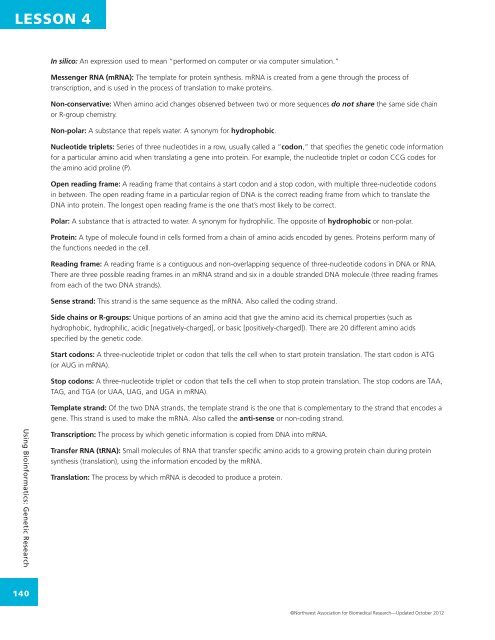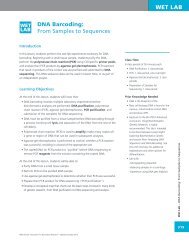LESSON 4 Using Bioinformatics to Analyze Protein Sequences
LESSON 4 Using Bioinformatics to Analyze Protein Sequences
LESSON 4 Using Bioinformatics to Analyze Protein Sequences
Create successful ePaper yourself
Turn your PDF publications into a flip-book with our unique Google optimized e-Paper software.
<strong>LESSON</strong> 4In silico: An expression used <strong>to</strong> mean “performed on computer or via computer simulation.”Messenger RNA (mRNA): The template for protein synthesis. mRNA is created from a gene through the process oftranscription, and is used in the process of translation <strong>to</strong> make proteins.Non-conservative: When amino acid changes observed between two or more sequences do not share the same side chainor R-group chemistry.Non-polar: A substance that repels water. A synonym for hydrophobic.Nucleotide triplets: Series of three nucleotides in a row, usually called a “codon,” that specifies the genetic code informationfor a particular amino acid when translating a gene in<strong>to</strong> protein. For example, the nucleotide triplet or codon CCG codes forthe amino acid proline (P).Open reading frame: A reading frame that contains a start codon and a s<strong>to</strong>p codon, with multiple three-nucleotide codonsin between. The open reading frame in a particular region of DNA is the correct reading frame from which <strong>to</strong> translate theDNA in<strong>to</strong> protein. The longest open reading frame is the one that’s most likely <strong>to</strong> be correct.Polar: A substance that is attracted <strong>to</strong> water. A synonym for hydrophilic. The opposite of hydrophobic or non-polar.<strong>Protein</strong>: A type of molecule found in cells formed from a chain of amino acids encoded by genes. <strong>Protein</strong>s perform many ofthe functions needed in the cell.Reading frame: A reading frame is a contiguous and non-overlapping sequence of three-nucleotide codons in DNA or RNA.There are three possible reading frames in an mRNA strand and six in a double stranded DNA molecule (three reading framesfrom each of the two DNA strands).Sense strand: This strand is the same sequence as the mRNA. Also called the coding strand.Side chains or R-groups: Unique portions of an amino acid that give the amino acid its chemical properties (such ashydrophobic, hydrophilic, acidic [negatively-charged], or basic [positively-charged]). There are 20 different amino acidsspecified by the genetic code.Start codons: A three-nucleotide triplet or codon that tells the cell when <strong>to</strong> start protein translation. The start codon is ATG(or AUG in mRNA).S<strong>to</strong>p codons: A three-nucleotide triplet or codon that tells the cell when <strong>to</strong> s<strong>to</strong>p protein translation. The s<strong>to</strong>p codons are TAA,TAG, and TGA (or UAA, UAG, and UGA in mRNA).Template strand: Of the two DNA strands, the template strand is the one that is complementary <strong>to</strong> the strand that encodes agene. This strand is used <strong>to</strong> make the mRNA. Also called the anti-sense or non-coding strand.<strong>Using</strong> <strong>Bioinformatics</strong>: Genetic ResearchTranscription: The process by which genetic information is copied from DNA in<strong>to</strong> mRNA.Transfer RNA (tRNA): Small molecules of RNA that transfer specific amino acids <strong>to</strong> a growing protein chain during proteinsynthesis (translation), using the information encoded by the mRNA.Translation: The process by which mRNA is decoded <strong>to</strong> produce a protein.140©Northwest Association for Biomedical Research—Updated Oc<strong>to</strong>ber 2012
















